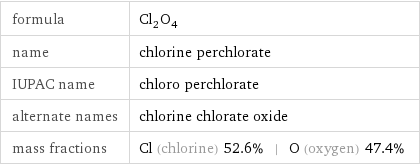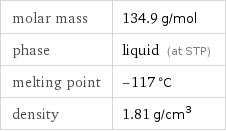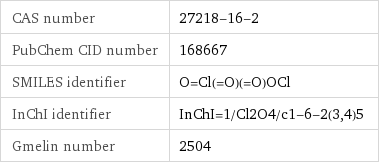Input interpretation

chlorine perchlorate
Chemical names and formulas

formula | Cl_2O_4 name | chlorine perchlorate IUPAC name | chloro perchlorate alternate names | chlorine chlorate oxide mass fractions | Cl (chlorine) 52.6% | O (oxygen) 47.4%
Lewis structure

Draw the Lewis structure of chlorine perchlorate. Start by drawing the overall structure of the molecule, ignoring potential double and triple bonds: Count the total valence electrons of the chlorine (n_Cl, val = 7) and oxygen (n_O, val = 6) atoms: 2 n_Cl, val + 4 n_O, val = 38 Calculate the number of electrons needed to completely fill the valence shells for chlorine (n_Cl, full = 8) and oxygen (n_O, full = 8): 2 n_Cl, full + 4 n_O, full = 48 Subtracting these two numbers shows that 48 - 38 = 10 bonding electrons are needed. Each bond has two electrons, so we expect that the above diagram has all the necessary bonds. However, to minimize formal charge oxygen wants 2 bonds. Identify the atoms that want additional bonds and the number of electrons remaining on each atom: In order to minimize their formal charge, atoms with large electronegativities can force atoms with smaller electronegativities on period 3 or higher to expand their valence shells. The electronegativities of the atoms are 3.16 (chlorine) and 3.44 (oxygen). Because the electronegativity of chlorine is smaller than the electronegativity of oxygen, expand the valence shell of chlorine to 7 bonds. Therefore we add a total of 3 bonds to the diagram: Answer: | |
Basic properties

molar mass | 134.9 g/mol phase | liquid (at STP) melting point | -117 °C density | 1.81 g/cm^3
Units

Liquid properties (at STP)

density | 1.81 g/cm^3
Units

Chemical identifiers

CAS number | 27218-16-2 PubChem CID number | 168667 SMILES identifier | O=Cl(=O)(=O)OCl InChI identifier | InChI=1/Cl2O4/c1-6-2(3, 4)5 Gmelin number | 2504
NFPA label

NFPA label

NFPA hazards | oxidizing agent